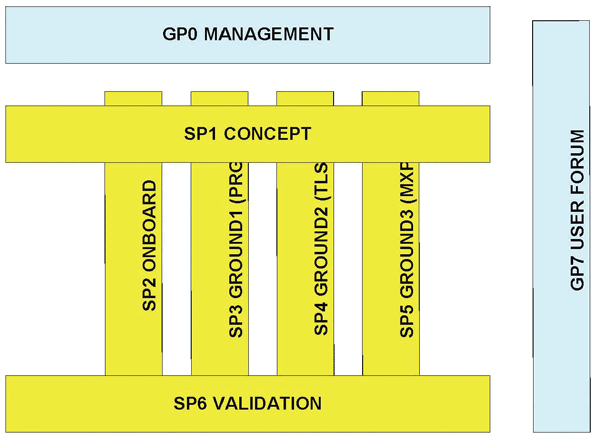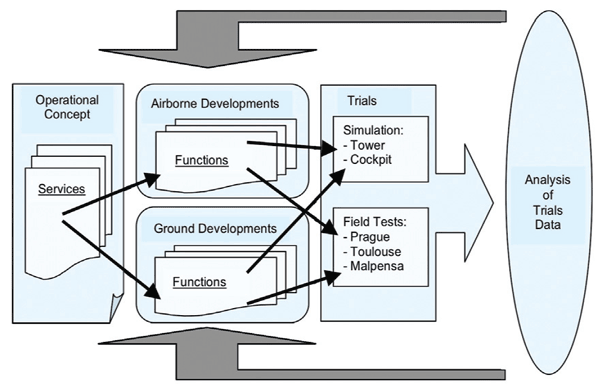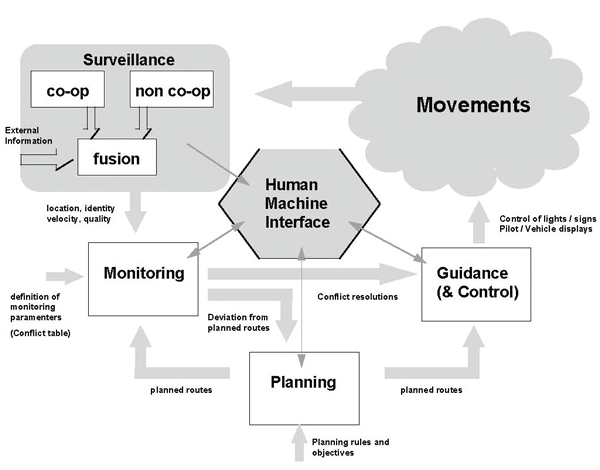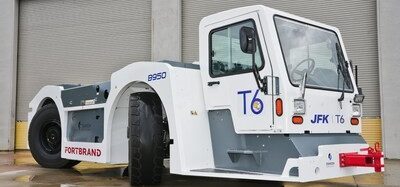Managing movement
Posted: 25 November 2005 | Michael Roeder, Project Manager, EMMA, German Aerospace Centre (DLR) | No comments yet
With airport capacity expected to become the major bottleneck in the future, the optimal usage of existing infrastructure is increasingly becoming a must, writes Michael Roeder.
With airport capacity expected to become the major bottleneck in the future, the optimal usage of existing infrastructure is increasingly becoming a must, writes Michael Roeder.
After touch down, pilots have to navigate using paper maps with controllers still performing surveillance visually. Radio voice transmission remains the primary means of communication. The controller is supported by the primary airport radar SMR, which gives him an analogue display with a lot of clutter and false targets. In order to ensure safety under bad weather conditions, low visibility procedures are used to handle the poor technology support. This compromises airport throughput and increases delays, which has repercussions for the approach areas and finally, network effects on the overall air transport system.
To improve this situation, a modular Advanced Surface Movement Guidance System (A-SMGCS) concept is defined in the ICAO Manual on A-SMGCS1. A-SMGCS systems are aiming to provide adequate capacity and safety in relation to specific weather conditions, traffic density and aerodrome layout. With A-SMGCS, ATS providers and flight crews are assisted in terms of surveillance, control, planning and guidance tasks. Today, some major airports have implemented A-SMGCS technology to levels I and II, and some have also started to adapt the operational procedures. However there is still a huge lag in using these systems to enable operations in all weather conditions. Therefore, the European Commission has funded A-SMGCS projects within the Framework Programmes (FP):
- FP4: DEFAMM (Demonstration Facilities for Airport Movement Management) to demonstrate the technology.
- FP5: BETA (operational Benefit Evaluation by Testing an A-SMGCS) for first implementations under operational conditions at two airports.
- FP6: EMMA (European airport Movement Management by A-SMGCS), which will pave the way to harmonise the implementation of A-SMGCS in a two step approach: Level (I & II) and higher level under adapted operational procedures.
Testing
Sample A-SMGCS systems will be installed at three mid-size airports: Prague Ruzyne, Milano Malpensa and Toulouse Blagnac. These will be used to control the regular airport traffic. Appropriate testing methodologies concerning functional and operational testing will be defined to ensure comparable results. EMMA will first consolidate the surveillance and conflict alert functions. The successor project EMMA2 will focus on advanced onboard guidance support to pilots and planning support to controllers. The results of these tests are intended to propose standards for future implementation in terms of:
- Common operational procedures;
- Common technical and operational system performance;
- Common safety requirements, and
- Common standards of interoperability with other ATM systems.
In order to meet the aforementioned objectives, EMMA is built upon previous work – especially from the ICAO Doc. 9830 on A-SMGCS [1] and from the Eurocontrol document2. The harmonised concepts of operations will be applied and validated thanks to functional and operational testing under real operational conditions. The active participation of licensed controllers and pilots from different countries is foreseen. These operators will be trained in simulation and on-site.
Finally, the Integrated Project EMMA will lead to comprehensive results which will support the regulation and standardisation bodies, as well as the industry, in the early and efficient implementation of A-SMGCS. Significant progress is expected in the maturation of technical equipment and on operational issues such as proper transponder switching. The benefit categories of an A-SMGCS will be identified and qualified.
Project structure
The project has been organised in six different sub-projects (SP1-SP6), which are co-ordinated by six different partners each (Figure 1). There are three ground-related sub-projects and one onboard-related sub-project, representing the three different test sites and the onboard ‘test’-site. The task of the Management sub-project is one of overall coordination. The sub-project ‘User Forum’ has a special meaning: because A-SMGCS directly affects the users as well as those who couldn’t participate in the whole, two public ‘User Forums’ will be carried out to give users outside of the EMMA consortium the possibility to contribute to the outcome of EMMA.
These four vertical sub-projects are to a certain degree, independent of each other. This procedure was used to minimise frictional losses, to have small, efficient sub-project-teams and to enable them to use existing systems or components. However, these four sub-projects are inter-linked with the horizontal sub-projects, ‘concept’ and ‘validation,’ to guarantee that the different test-site systems are based on a common concept and that all are validated with the same criteria.
The project is following an iterative development process with system maturing phases, followed by functional and operational testing phases. Two test campaigns are planned. Licensed controllers and pilots, as well as aircraft and ground vehicles, will be involved in testing in order to gain realistic results. Controllers and pilots will be trained in simulation and on-site to prepare them to cope with a level 1 or 2 A-SMGCS under real operational conditions.
Although all ground test sites have their own, specific functional focus, the aforementioned principal A-SMGCS structure (Figure 3) level I & II (Surveillance & Control) can be found at every test airport. In order to meet the project goals, ‘harmonisation’ and ‘consolidation’, the technical solutions at these test sites go in line with standard requirements, but are also able to consider local constraints. Although different products from several manufacturers are used, ma definite level of standardisation must not be fallen below.
Functions
In EMMA, only the surveillance and alerting functions will be implemented and used fully operationally. More advanced functions like guidance and planning, will only be prepared for EMMA2 where they shall be implemented finally. The exception to this is the on-board part; EMMA will provide the pilot with his own position and the airport surface by a Moving Map Display. This display is the basis for the higher, on-board A-SMGCS levels like guidance and autonomic conflict detection that will be followed up in EMMA2. The airport selection for EMMA has taken into account that real operational tests have to be performed there, assuming:
- available resources for installations and testing
- the possibility to install additional equipment on ground
- the possibility to install fully equipped EMMA controller working positions
To follow the ICAO definitions1 regarding surveillance and control requirements, it is expected that more than one type of surveillance sensor will be needed to meet the surveillance requirements. In clear words: to ensure identification and continuous tracking, there is the need of a sensor set in dependence of the airport layout. This sensor set must be defined in such a way that redundant information sources – fused by a sensor data fusion – are available to survive short term single sensor faults and to approve the information validity.
Every test airport consists of one non cooperative sensor (ASR, SMR) and one cooperative sensor (MLAT) at least. There is also an additional cooperative sensor at Prague and Toulouse based on the ADS-B technology. Identified gaps are covered by additional sensors (gap fillers). All data gets fused within a sensor data fusion and will be presented to the controller via a controller HMI based on a complete working position. The amount of working positions depends on the operational requirements of the airport. Every airport provides a test bed for shadow mode trials and real operational working positions.
Validation is the last step in the development and integration process before ATM systems are taken in every day operational control. After assuring an adequate performance in the verification phase of the ATM system, validation completes the cycle by including the user’s judgement about the right operation of the system.
Safety considerations
In the first step of A-SMGCS implementation, the safety aspect may increase significantly because of the higher situation awareness that the controllers will be provided with through this system. If the system performance leads to new operational procedures (e.g. Head down procedures within low visibility, assuming that the system acceptance is approved by the controllers.) the benefit will move more to the capacity indicators, better defined as throughput. This throughput will increase mainly under low visibility conditions, thanks to the accepted surveillance presentation to the controllers.
The so called increase of capacity will be affected, more or less, only by the higher level of A-SMGCS. An increase of capacity assumes that the airport is working on its maximum throughput and only automatic planning and automatic guidance could positively influence the bottleneck.
Achievements so farAlready achieved
Nineteen months after the project started, EMMA has achieved the following:
- A harmonised definition of A-SMGCS levels I & II in partnership with Eurocontrol.
- The outlining of higher-Level services, equipment and procedures.
- Development of an algorithm and analysis tool (MOGADOR by CENA/DSNA) to assess surveillance and alerting performance.
- Delivery of a methodology for verifying and validating A-SMGCS Systems.
- Surveillance performance assessment at the biggest European Hub, Paris Charles de Gaulle Airport.
- RWY-Incursion Scenarios tested in Real Time Simulation for Prague and Malpensa and Systems tuned to operational needs.
- Functional Hazard Assessment (FHA) and Preliminary System Safety Assessment (PSSA) conducted.
- Three different MLAT Systems are under development
- in Toulouse by Thales ATM and
- in Malpensa by SELEX (formerly Alenia Marconi Systems)
- in Prague by ERA under operational use
- A full A-SMGCS test-bed has been built up in Prague and made ready for operational trials.
- Real Time Simulation was performed:
- Prague at DLR Simulator
- Malpensa at NLR Simulator
- On-board at Airbus- and DLR Simulator
- ADS-B solutions using 1090ES integrated and under test.
- Onboard Guidance planned to demonstrate in
- Revenue Aircraft
- DLR Test Aircraft
- Test Vehicles of the Technical University of Darmstadt
When the project ends on 31st March 2006 it should finally be proven that it is possible to work fully head-down with an A-SMGCS. In addition, large implementation programmes like the European SESAME should be able to use the R&D results coming out of projects like EMMA for their implementation decisions. Last but not least, the A-SMGCS R&D community has to now start the technical and especially operational maturing process of the higher A-SMGCS levels – looking forward to EMMA2.
For further information please go to www.dlr.de/emma.


Figure 1: Sub-project structure of EMMA


Figure 2: Iterative approach of EMMA


Figure 3: Principal A-SMGCS structure
References
- ICAO Doc. 9830, (2004), Advanced Surface Movement Guidance and Control Systems (A-SMGCS) Manual, First Edition, ICAO Montreal, Canada
- Adamson P. (2003), Definition of A-SMGCS Implementation Levels, EUROCONTROL Brussels, Belgium
Michael Roeder
Michael Roeder is a member of the German Aerospace Center (DLR) and is currently the project manager of the European project EMMA. Throughout his ten years in aviation, Michael has worked at DLR in the Human Engineering and Simulation Department, in the research areas of ATM and in Airborne HMI. In between 1999 and 2001, he was the team leader of the Simulation Group. Since 2001, he has been working in the Operations Control Department at DLR, mainly dealing with A-SMGCS.
Stay Connected with International Airport Review — Subscribe for Free!
Get exclusive access to the latest airport and aviation industry insights from International Airport Review — tailored to your interests.
✅ Expert-Led Webinars – Gain insights from global aviation leaders
✅ Weekly News & Reports – Airport innovation, thought leadership, and industry trends
✅ Exclusive Industry Insights – Discover cutting-edge technologies shaping the future of air travel
✅ International Airport Summit – Join our flagship event to network with industry leaders and explore the latest advancements
Choose the updates that matter most to you.
Sign up now to stay informed, inspired, and connected — all for free!
Thank you for being part of our aviation community. Let’s keep shaping the future of airports together!

















